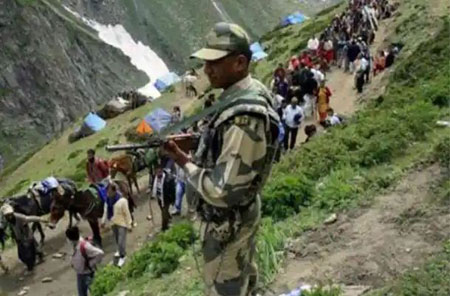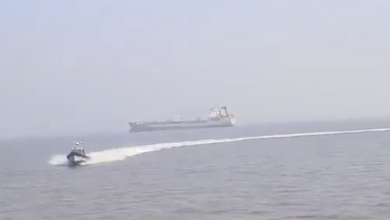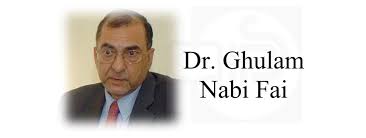Pilgrimage at a Price: Impact of Amarnath Yatra on the fragile Himalayan ecosystem
Humayun Aziz Sandeela

The Amarnath Yatra, an annual Hindu pilgrimage to the Amarnath Cave located at an altitude of 3,888 meters in the Himalayasin Indian illegally occupied Jammu and Kashmir, attracts hundreds of thousands of devotees each year. Although this significant religious event has both cultural and economic importance, but it also has raised environmental concerns, particularly regarding its impact on the fragile ecosystem of the region.
The Amarnath cave is home to an ice stalagmite revered as a physical manifestation of Hindu deity, Lord Shiva. The pilgrimage occurs over 45 days in the summer when the cave is accessible.
Despite efforts by the Dogras to popularize the Amarnath Yatra since the late 19th century, it never fully integrated into the social fabric of Kashmir, even with a significant presence of Kashmiri Pandits (Hindus) in the region, their participation remained insignificant. But since the 1980s, the yatra has experienced a significant resurgence.
Since 1963 India meticulously started gathering data on the number of yatris, with a particularly remarkable surge observed between 1980 and 1985. Official data shows that the number of worshippers rose from 4,500 in 1950 to 353,969 in 2013. In 2019, despite the pilgrimage being shortened to 32 days, 342,883 people visited the shrine. According to a report by the Times of India, the cave was visited by a total of 304,000 visitors in 2022 while in 2023 more than 428,000 pilgrims took part in the Amarnath Yatra.
This dramatic rise coincided with the emergence of far-right Hindu militant groups in India. During this period, the Vishwa Hindu Parishad (VHP) and its subsidiary Bajrang Dal were particularly active in reviving Hindu nationalism. In the case of the Amarnath Yatra, this revival was achieved in two key ways. First, government support, which had been minimal until then, became crucial in ensuring the yatra’s success and smooth execution. Second, the duration of the yatra was gradually extended to encourage greater participation from across India, which reached 63 days in 2023.
In the 1990s, efforts were made to align the pilgrimage with an Indian nationalist agenda, countering Kashmiri demands for independence from India. In 2001, the Indian government solidified its control over the yatra by establishing the Shri Amarnath Yatra Shrine Board (SASB). This move asserted state patronage and ownership, ostensibly to provide essential amenities to the yatris.
The establishment of the Board not only ensured state patronage but also served as a facade for the deployment of Indian armed forces. It became a mobilization tool, encouraging people across India to participate in the Yatra and demonstrate their loyalty to the nation. The religious nature of the Yatra was transformed into a symbol of national pride, as highlighted in a 1997 Press Information Bureau Feature Release.“Faith can move mountains, so goes an old adage. With a little variation to the saying, it is hoped that the yearning for Moksha (salvation) can move the devotees to the challenging heights of Kashmir. This will also be a befitting gesture of solidarity with our valiant soldiers who have been fighting the enemy to defend our borders.”
In 2008, the Government of India proposed transferring 100 acres of forest land to the SASB for constructing huts and other infrastructure for Amarnath yatris. This proposal raised suspicions among Kashmir’s pro-freedom leaders, who believed it was an attempt to settle non-local Hindus in the region. This suspicion led to a two-month-long agitation and widespread protests throughout Kashmir. Over 100 civilians were killed, and more than 1,000 protesters were injured. The widespread protests forced the Indian government to shelve its plan for the land transfer to the SASB.
Environmentalists have time and again raised concerns over the unregulated influx of visitors to Amarnath citing Jammu and Kashmir’s sensitive environment and its crucial role in providing water and environmental stability. In the wake of these concerns, in 2012, the Supreme Court of India constituted a Special High-Power Committee. The committee acknowledged the fragility and vulnerability of the ecosystem, emphasizing the importance of calculating, minimizing, and controlling the impact of human activities, but these suggestions have never seen light of the day. The committee also neglected to address vital issues such as noise pollution and the substantial impact of heavy footprint of humans on glaciers, the Lidder and Sindh Rivers, and the surrounding forests and meadows.
Despite the longstanding environmental concerns associated with the yatra, the SHPC focused on yatri safety rather than environmental issues. Previous committees, such as the Sengupta Committee of 1996 and the Mukherjee Committee of 2000, were also established to ensure yatri safety. These committees recommended regulating the number of yatris traveling through the fragile landscape daily.
In 2006, the Jammu and Kashmir Pollution Control Board released a report highlighting critical environmental issues and reinforced the importance of controlling the daily number of pilgrims on both pilgrimage routes.However, these recommendations have never been implemented, neither for yatra safety nor environmental protection, suggesting that the journey’s purpose extends beyond a mere religious pilgrimage.
Furthermore, a response to an RTI filed with the Shrine Board confirmed that no carrying capacity study has been conducted to determine the number of yatris per day or season, nor has any environmental impact assessment of the entire yatra been carried out.
There is no denying the fact that the influx of pilgrims generates a significant amount of waste, including plastic bottles, food wrappers, and other non-biodegradable materials. Despite efforts by authorities to manage waste, the sheer volume often exceeds the capacity for proper disposal, leading to littering along the trek routes and camping sites. Sanitation facilities are often inadequate to handle the large number of pilgrims, resulting in improper disposal of human waste. This not only pollutes the soil and water but also poses health risks to both humans and wildlife. Apart from heavy footprint of pilgrims, this year the Indian government has deployed more than 100 companies of troops along the Pahalgam route, and another 90 companies along the Baltal route in the Kashmir Valley.
Meanwhile, the construction of temporary shelters, stalls, and other infrastructure to accommodate pilgrims leads to deforestation and land degradation. The relentless cutting of trees and clearing of vegetation to make room for these structures is severely disrupting the natural habitat.
The pilgrimage route traverses several streams and rivers that serve as water sources for local communities and wildlife. The disposal of waste and human activities often result in the contamination of these water bodies, adversely affecting water quality and ecosystem health.
Increased human activity in the region also contributes to the accelerated melting of glaciers. Pollution and climate change induced by human activities raise temperatures, which in turn speeds up glacial melt, impacting the water availability downstream.
Rebecca Byerly in her report for National Geographic in 2012 also pointed out the same phenomenon that a glacier is subzero, but thousands of people emit radiation at 37 degrees Celsius, whether it is yatrior a helicopter there is a big radiation and temperatures rise. So, definitely that encourages the melting of snow and glacier resources in the region.
The transportation of hundreds of thousands of pilgrims by vehicles contributes to carbon emissions. The increased use of fossil fuels for travel adds to the region’s carbon footprint, exacerbating climate change impacts.
Meanwhile, the energy required to support the pilgrimage, including cooking, heating, and lighting, often relies on non-renewable energy sources, further contributing to greenhouse gas emissions.
The environmental degradation and pollution associated with the pilgrimage has also disrupted the local weather patterns. Changes in precipitation and temperature can have cascading effects on the region’s climate and biodiversity.
A study conducted in 2019 by European Geoscience Union revealed that the average annual temperature in Kashmir has increased by 0.8˚C over a span of 37 years (1980-2016). In recent years, many summers have experienced record-breaking temperatures.The rise in global temperatures has led to reduced snow accumulation in higher mountains, resulting in shorter periods of water availability due to faster melting snow. Considering the context of climate change, it is crucial to take the Amarnath Yatra into account.
Kashmir is also located in seismic zone V, making it highly susceptible to earthquakes. Over the past two decades, the region has experienced more than 100 earthquakes, with the most devastating one in 2005 resulting in over 1,300 deaths and more than 6,000 injuries in occupied Kashmir. Climate change has been linked to increased seismic activity, highlighting the potential risk posed by the large-scale Amarnath Yatra in such a high-risk earthquake zone.
In the wake of the abrogation of Kashmir’s semi-autonomous status in 2019, India’s efforts to implement a settler-colonial project aimed at significant demographic changes have accelerated. The extension of the Yatra period to 63 days in 2023 indicates how Hindu religious tourism is being aligned with this agenda. Despite the ecological fragility of the region, the Indian government is determined to promote the “Hinduisation” of Kashmir, furthering the broader Hindutva project and reinforcing its claims on the region.
This year, the 52-day Hindu pilgrimage commenced from the twin tracks on June 29 and will conclude on August 19, 2024.








